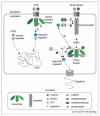Evolution and phyletic distribution of two-component signal transduction systems
- PMID: 20133179
- PMCID: PMC3391504
- DOI: 10.1016/j.mib.2009.12.011
Evolution and phyletic distribution of two-component signal transduction systems
Abstract
Two-component signal transduction systems are abundant in prokaryotes. They enable cells to adjust multiple cellular functions in response to changing environmental conditions. These systems are also found, although in much smaller numbers, in lower eukaryotes and plants, where they appear to control a few very specific functions. Two-component systems have evolved in Bacteria from much simpler one-component systems bringing about the benefit of extracellular versus intracellular sensing. We review reports establishing the origins of two-component systems and documenting their occurrence in major lineages of Life.
Copyright 2010 Elsevier Ltd. All rights reserved.
Figures


References
-
-
Stock AM, Robinson VL, Goudreau PN. Two-component signal transduction. Ann Rev Biochem. 2000;69:183–215. This is by far the most comprehensive, authoritative review on TCS.
-
-
-
Ulrich LE, Zhulin IB. The MiST2 database: a comprehensive genomics resource on microbial signal transduction. Nucleic Acids Res. 2009 doi: 10.1093/nar/gkp940. This paper describes a continuously updated database that classifies TCS components in all prokaryotic genomes. It includes the first attempts to delineate evolutionary relationships between TCS proteins on the basis of domain orthology and also catalogs HHK and HRR proteins as distinct types of TCS components.
-
-
- Alex LA, Simon MI. Protein histidine kinases and signal transduction in prokaryotes and eukaryotes. Trends Genet. 1994;10:133–138. - PubMed
Publication types
MeSH terms
Substances
Grants and funding
LinkOut - more resources
Full Text Sources
Other Literature Sources

